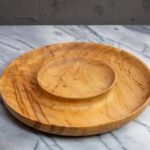Are computers used in woodworking design? Woodworking design has long been a meticulous and intricate process, traditionally undertaken with the use of manual tools and techniques. However, the advancements in technology have revolutionized the woodworking industry, introducing computers as valuable tools in the design process. These technological innovations have not only enhanced precision and accuracy but also opened up new possibilities for customization and collaboration.
In the past, woodworking design relied heavily on traditional methods such as hand-drawn sketches, physical prototypes, and manual measurements. While these methods hold their own charm and craftsmanship, the introduction of computers has significantly transformed the way woodworking designs are conceptualized and created. This article will explore the role of computers in woodworking design, from their use in creating intricate designs to their impact on production processes.
As technology continues to evolve, it is essential to understand how its integration into woodworking design has brought about a paradigm shift in the industry. The traditional boundaries of woodworking craftsmanship are being redefined by the capabilities of computer technology, paving the way for a future where innovation and creativity intersect with technological advancements.
The Role of Computers in Woodworking Design
Woodworking design has traditionally involved the use of manual tools and techniques to create intricate and detailed designs in wood. However, with the advancement of technology, computers have become integral to the woodworking design process. The use of computers and specialized software has revolutionized the way woodworking designs are created, offering a wide range of benefits to designers, manufacturers, and clients.
One of the primary ways computers are used in woodworking design is through the utilization of Computer-Aided Design (CAD) software. CAD software allows designers to create precise and detailed digital models of their woodworking designs, providing a level of accuracy and detail that is difficult to achieve with traditional hand-drawing methods. These digital models can then be easily modified and manipulated to explore different design variations, leading to greater creativity and flexibility in the design process.
In addition to CAD software, Computer-Aided Manufacturing (CAM) software plays a crucial role in woodworking production. CAM software enables the translation of digital woodworking designs into physical woodwork by guiding CNC machines in cutting, shaping, and carving wood according to the specifications outlined in the digital models. This seamless integration between design and manufacturing processes improves efficiency and precision in woodworking production.
| Aspect | Role |
|---|---|
| Precision | Contributes to precision and accuracy of woodworking designs |
| Customization | Allows for greater customization and flexibility in woodworking design |
| Collaboration | Facilitates collaboration between woodworking designers, manufacturers, and clients |
CAD/CAM Software
Computer-aided design (CAD) and computer-aided manufacturing (CAM) software have revolutionized the woodworking design process, allowing for greater precision and efficiency in creating intricate and customized woodwork.
Role of Computer-Aided Design (CAD) Software
CAD software plays a crucial role in the initial stages of woodworking design, providing designers with the tools to create detailed and accurate 2D and 3D models of their projects. These digital representations allow for precise measurements, angles, and aesthetics to be visualized before any physical construction takes place. This not only saves time and resources but also enables designers to experiment with different variations of their designs without having to physically build multiple prototypes.
Impact of Computer-Aided Manufacturing (CAM) Software
Once a design has been finalized using CAD software, CAM software comes into play to translate the digital model into physical woodwork. By generating toolpaths for cutting, shaping, and carving based on the CAD model, CAM software ensures that the final product matches the designer’s vision with precision. CNC (computer numerical control) machines then execute these toolpaths with remarkable accuracy, resulting in woodwork that is consistent and high-quality.
With CAD/CAM software at their disposal, woodworking designers can achieve levels of intricacy and complexity that would be nearly impossible with traditional methods alone. The integration of computers in woodworking design not only enhances the creative possibilities but also improves overall efficiency and accuracy in bringing those designs to life.
Overall, CAD/CAM software has significantly transformed woodworking design by offering new creative possibilities while ensuring precision and accuracy in the production process. The marriage of traditional craftsmanship with modern technology continues to push the boundaries of what is possible in woodworking design.
Precision and Accuracy
Computer-Aided Design (CAD) Software
Computer-Aided Design (CAD) software plays a crucial role in achieving precision and accuracy in woodworking design. This software allows designers to create detailed 3D models of their woodwork, providing a level of specificity that can be challenging to achieve through traditional methods alone. By using CAD software, designers can precisely measure and manipulate various components of their designs, ensuring that every detail is meticulously planned and executed.
Computer-Aided Manufacturing (CAM) Software
In addition to CAD software, Computer-Aided Manufacturing (CAM) software further enhances the precision and accuracy of woodworking production. CAM software takes the digital designs from CAD programs and translates them into instructions for CNC machines. These instructions guide the machines in cutting, shaping, and carving wood with unparalleled accuracy, resulting in high-quality finished products that closely match the original digital designs.
Role of CNC Machines
One of the most significant contributions to precision and accuracy in woodworking design comes from Computer Numerical Control (CNC) machines. These automated tools receive commands from CAD/CAM software and execute them with remarkable precision by following a set of predetermined coordinates.
As a result, the margin for error commonly associated with manual woodworking processes is greatly reduced. CNC machines enable intricate details, complex shapes, and tight tolerances to be consistently replicated with utmost accuracy across multiple iterations of the design.
Overall, computers are indispensable in ensuring precision and accuracy throughout the woodworking design process. From the initial creation of detailed digital models using CAD software to the precise execution of those designs by CNC machines guided by CAM software, technology has revolutionized the industry by allowing for unprecedented levels of perfection and consistency in woodworking craftsmanship.
Customization and Flexibility
Computers have revolutionized the woodworking design process, allowing for greater customization and flexibility in creating intricate and unique designs. The use of computer software in woodworking design has opened up countless possibilities for craftsmen and designers to experiment with various styles, shapes, and details. Here are some ways computers have facilitated customization and flexibility in woodworking design:
- Design Modification: With the use of CAD software, designers can easily modify and adjust their woodworking designs to suit specific requirements or preferences. Whether it’s changing the dimensions of a piece of furniture or adding intricate details to a wood carving, computer software allows for quick and efficient alterations.
- Experimentation: Computers provide woodworking designers with the ability to experiment with different design elements without the need to create physical prototypes. This allows for greater creativity and innovation, as designers can explore various options before settling on a final design.
- Personalization: The use of computer software enables designers to personalize their woodworking designs according to the preferences of clients. Whether it’s incorporating initials into a custom woodwork piece or creating unique patterns based on specific requests, computers allow for a high level of personalization in woodworking design.
Overall, computers have significantly enhanced the customization and flexibility aspects of woodworking design, providing designers with powerful tools to bring their creative visions to life. The ability to easily modify and experiment with designs using computer software has transformed the way woodworking designs are conceptualized and executed.
In addition to customization and flexibility, the integration of technology has also streamlined communication between designers, manufacturers, and clients within the woodworking industry. Digital platforms enable seamless collaboration and efficient exchange of ideas, further enhancing the overall design process in this traditional craft.
Collaboration and Communication
The role of computers in woodworking design extends beyond the creation of intricate designs and precise measurements. One major advantage is the facilitation of collaboration and communication between woodworking designers, manufacturers, and clients. With the help of computer software and digital platforms, the exchange of ideas and feedback has become more streamlined and efficient.
Below are some ways computers are used in woodworking design to enhance collaboration and communication:
- Digital Design Platforms: Utilizing Computer-Aided Design (CAD) software allows multiple designers to work on the same project simultaneously. This enables real-time collaboration, as changes and modifications can be seen by all parties involved, promoting a more cohesive workflow.
- Virtual Meetings: Through video conferencing tools, woodworking designers can easily communicate with clients and manufacturers regardless of their physical locations. This not only saves time and resources but also fosters a more transparent and inclusive design process.
- Online Project Management: Various software offer project management features that allow for easy organization of tasks, deadlines, and resources. This helps ensure that everyone involved in the woodworking design process stays on track and informed.
Given these benefits, it’s evident that computers play a crucial role in enhancing collaboration and communication within the woodworking industry. As technology continues to advance, it’s likely that new tools and platforms will further streamline these aspects of woodworking design, ultimately leading to greater efficiency and creativity in the field.
Challenges and Limitations
Woodworking design has traditionally been a hands-on craft, relying on the expertise and creativity of skilled artisans. However, with the advancements in technology, computers are now being increasingly used in woodworking design. One of the major challenges in integrating computers into this traditional craft is the learning curve associated with mastering new software and tools for woodworking design. Many experienced woodworkers may find it challenging to adapt to these new methods and abandon their familiar techniques.
Another limitation of using computers in woodworking design is the potential drawbacks of relying too heavily on technology. While computer-aided design (CAD) software and computer-aided manufacturing (CAM) software offer many benefits, including precision, accuracy, and flexibility in design, there is a risk of losing the tactile experience and craftsmanship that are inherent to traditional woodworking. Over-reliance on computers may lead to a disconnect from the artistry and skill that define woodworking as a craft.
Furthermore, as with any technological integration, there are potential challenges with compatibility, maintenance, and updates when incorporating computers into woodworking design. Ensuring that the software and hardware used for woodworking design are up-to-date, compatible with existing systems, and reliable can present challenges for woodworkers who may not have extensive experience with technology.
| Challenges | Limitations |
|---|---|
| Learning curve associated with mastering new software | Potential drawbacks of relying too heavily on technology |
| Risk of losing tactile experience and craftsmanship | Compatibility, maintenance, and updates challenges |
The Future of Woodworking Design
One of the key factors driving the future of woodworking design is the continual evolution of Computer-Aided Design (CAD) software. CAD programs have revolutionized the way designers conceptualize and create woodworking designs, allowing for greater precision, detail, and efficiency. As these software platforms become more sophisticated and user-friendly, designers can expect to have access to even more powerful tools that enhance their ability to bring their creative visions to life.
Another trend that points towards the future of woodworking design is the rise of Computer-Aided Manufacturing (CAM) software. CAM programs work hand-in-hand with CAD software to streamline and optimize the production process, offering features such as automated toolpath generation and real-time machine simulation. This convergence of design and manufacturing capabilities through computer technology has significant implications for how woodworkers approach their craft, leading to increased productivity and quality in production.
Looking ahead, it is clear that customization and flexibility will continue to be driving forces behind innovation in woodworking design. Computers allow for easy modification and experimentation with designs through digital manipulation, opening up possibilities for unique, personalized creations that were once much more challenging to achieve using traditional methods alone. The integration of 3D modeling tools and virtual reality applications also present exciting opportunities for immersive design experiences that push the boundaries of traditional craftsmanship.
Overall, as we peer into the future of woodworking design, it is evident that computers are positioned at the forefront of ongoing innovation in this industry. Embracing these technological advancements offers endless possibilities for creativity, efficiency, and collaboration within woodworking design, paving a path towards a future where tradition meets cutting-edge technology in perfect harmony.
Conclusion
In conclusion, it is evident that computers have become an integral tool in woodworking design. The traditional methods of hand-drawn sketches and manual measurements are being complemented, and often replaced, by sophisticated computer software and hardware. The introduction of Computer-Aided Design (CAD) and Computer-Aided Manufacturing (CAM) software has revolutionized the precision, accuracy, customization, and flexibility in woodworking design. This advancement in technology has also facilitated better collaboration and communication between designers, manufacturers, and clients.
While the use of computers in woodworking design has brought about numerous benefits, there are also challenges and limitations to consider. One such challenge is the learning curve associated with mastering complex CAD/CAM software. Additionally, there may be drawbacks to relying too heavily on technology in a traditionally hands-on craft. Nonetheless, as technology continues to advance at a rapid pace, it is likely that future innovations will address these challenges and further integrate computers into the woodworking industry.
Looking ahead, the future of woodworking design is undeniably intertwined with computer technology. As advancements continue to shape the way designs are conceptualized, communicated, and produced, it is expected that woodworking will become more precise, efficient, and adaptive. Ultimately, while computers are indeed used extensively in woodworking design today, their role is only expected to evolve further as new technologies emerge.
Frequently Asked Questions
Do Carpenters Use Computers?
Yes, carpenters do use computers in their work. They may use computers for tasks such as creating and reading blueprints, communicating with clients and suppliers, managing their schedules, and researching new techniques or materials.
Do Carpenters Use CAD?
Some carpenters do use computer-aided design (CAD) software to create detailed plans and models of their woodworking projects. This can help them visualize the final product, make precise measurements, and generate accurate cutting diagrams.
What Is CAD in Woodworking?
CAD in woodworking refers to the use of computer-aided design software to plan and design woodworking projects. This technology allows carpenters to create detailed 3D models of their projects, make precise measurements, explore different design options, and generate cutting diagrams that can be used in the workshop. Overall, CAD helps improve accuracy, efficiency, and precision in woodworking.

Hi everyone! I’m a woodworker and blogger, and this is my woodworking blog. In my blog, I share tips and tricks for woodworkers of all skill levels, as well as project ideas that you can try yourself.





